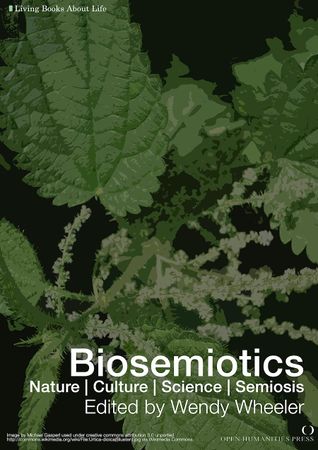Biosemiotics

Biosemiotics: Nature/Culture/Science/Semiosis
edited by Wendy Wheeler
Wendy Wheeler
Donald Favareau
[http://www.biosemiotics.org/favareau/ The Evolutionary History of Biosemiotics
Thomas A. Sebeok
Semiotics and the Biological Sciences: Initial Conditions
Kalevi Kull
Jakob von Uexküll: An Introduction
Kalevi Kull
Organism as a self-reading text: anticipation and semiosis
Kalevi Kull and Jesper Hoffmeyer
Thure von Uexküll 1908-2004
Jesper Hoffmeyer
Epilogue to Semiotics: Biology is Immature Biosemiotics
Jesper Hoffmeyer
Semiotic Freedom: An Emerging Force
Kalevi Kull
Biosemiotics: To know, what life knows
Kalevi Kull, Terrence Deacon, Claus Emmeche, Jesper Hoffmeyer, Frederik Stjernfelt
Theses on biosemiotics: Prolegomena to a theoretical biology
Søren Brier
Cybersemiotics: An Evolutionary World View Going Beyond Entropy and Information into the Question of Meaning
Frederik Stjernfelt
The Semiotic Body
John Deely
The Green Book: The Impact of Semiotics on Philosophy'
John Deely A Dialogue: "A Sign is What!?" ("a sign is that which presupposes an object")
John Deely, (2004) “A sign is what?”. Original written dialogue. URL: http://www.ut.ee/SOSE/pdf/deely_Semiotic_Sign_Dialogue.pdf. See also John Deely's Bibliography: 2004g. "Dramatic Reading in Three Voices: 'A Sign is What?'", American Journal of Semiotics 20.1-4 (2004), 1-66. http://www.morec.com/semiotic/.
Terrence Deacon, Lecture. ‘Language and complexity: Evolution inside out’. You Tube. Video. URL: http://www.youtube.com/watch?v=OT-zZ0PMqgI.
Gregory Bateson, (1988 and 2002) Chapters 2 and 3 of G. Bateson, Mind and Nature: A Necessary Unity, Cresskill NJ: Hampton Press, 2002. Chapters 2 and 3 of G. Bateson and M.C. Bateson, Angels Fear: Towards an Epistemology of the Sacred, London: Bantam Books, 1988. URL: http://www.oikos.org/baten.htm#Articles.
Peter Harries-Jones, (2010) 'Bioentropy, Aesthetics and Meta-dualism: The Transdisciplinary Ecology of Gregory Bateson', Entropy 12, no. 12: 2359-2385. URL: http://www.mdpi.com/1099-4300/12/12/2359/.
Paul Cobley, (2007) ‘Semioethics, Voluntarism and Anti-humanism’, New Formations 62, Autumn 2007. URL: http://www.lwbooks.co.uk/journals/newformations/archive/newformations62.html.
Susan Petrilli, (2007) ‘Significs and Semioethics. Places of the Gift in Communication Today’, in Genevieve Vaughan (ed.), Women and the Gift Economy: A Radically Different Worldview is Possible, Toronto: Inanna Publications and Education Inc./Canadian Woman Studies/les cahiers de la femme, 2007, pp. 108-120. URL: http://www.susanpetrilli.com/letture_in_rete_inglese.htm.
Wendy Wheeler, (2010) ‘Gregory Bateson and Biosemiotics: Transcendence and Animism in the 21st Century', special issue on Ecophenomenology and Practices of the Sacred, guest eds P. Curry and W. Wheeler, Green Letters: Studies in Ecocriticism vol. 13 (Winter 2010). URL: http://www.londonmet.ac.uk/depts/hal/staff/research-profiles/professor--wendy-wheeler.cfm.
